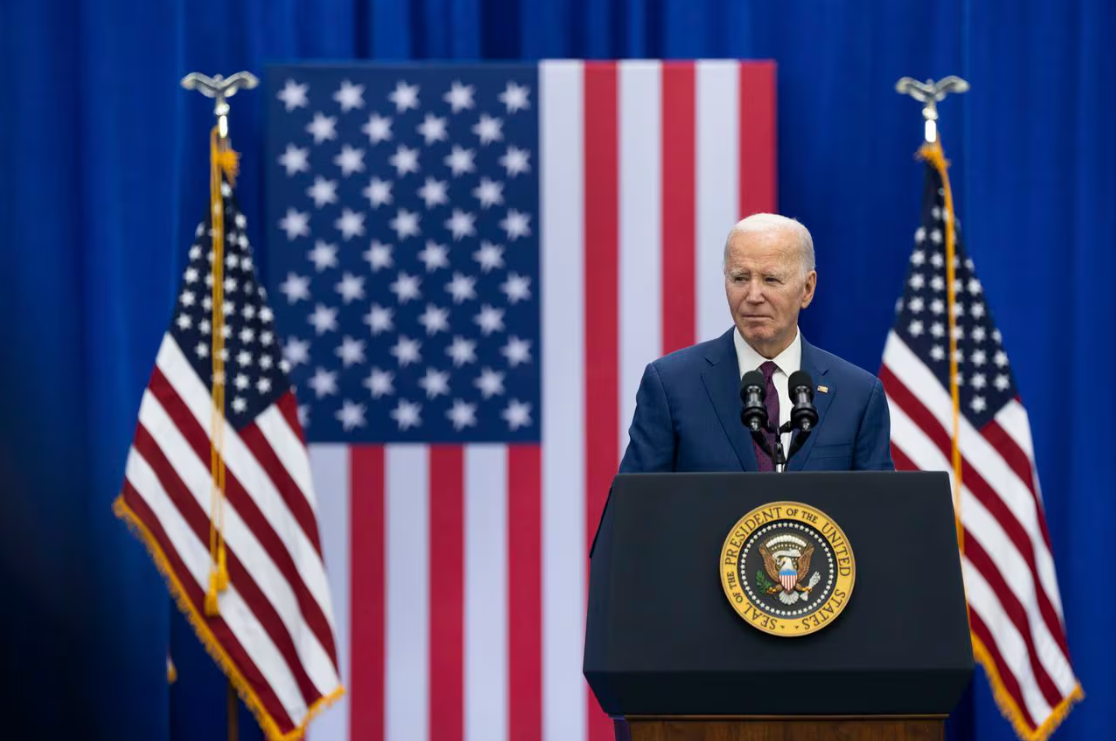拜登的预算凸显了与共和党和特朗普的分歧

【中美创新时报2024年3月12日华盛顿讯】(记者温友平编译)拜登总统周一(3月11日)提出了一项 7.3 万亿美元的预算,其中包括对企业和高收入者增税、社会项目新支出,以及一系列旨在应对高消费成本(包括住房和大学学费)的措施。对此,《纽约时报》记者吉姆·坦克斯利(Jim Tankersley)进行了下述报道。
该提案仅对拜登去年提交的预算计划进行了相对较小的修改,该计划在国会没有任何进展。然而,它再次呼吁议员们花费约1000亿美元来加强边境安全并向以色列和乌克兰提供援助。
鉴于共和党控制众议院并坚决反对拜登的经济议程,2025 财年预算中包含的大部分新支出和增税措施今年几乎没有机会成为法律。上周,众议院共和党人通过了一项预算提案,概述了他们的优先事项,这与民主党所寻求的相去甚远。
相反,该文件将作为拜登在 11 月寻求连任时的政策纲领草案,并进行一系列对比,旨在与其假定的共和党对手、前总统特朗普区分开来。
拜登试图在经济问题上重新赢得选民的支持,而在通货膨胀加剧的情况下,选民给他的评分很低。该预算旨在将他描绘成增加政府对工人、家长、制造商、退休人员和学生的援助以及应对气候变化的倡导者。
拜登周一在新罕布什尔州发表讲话,宣称该预算是通过提高对最富有的美国人和大公司的税收来增加收入以支付他的优先事项的一种方式。
“我并不反对公司,”他说。“我是一个资本家,伙计。赚你想要的所有钱。开始缴纳你应得的税款吧。”
预算提议在十年内对企业和富人征收约 5 万亿美元的新税。政府官员周一表示,这些增加的税款将由企业和美国最高收入者平均分配,年收入低于 40 万美元的美国人将根据他们的计划享受总计 7500 亿美元的减税。
白宫预算办公室主任沙兰达·杨(Shalanda Young)对记者表示:“我们可以通过要求收入最高的 1% 和 2% 的人向系统支付更多费用来完成所有投资。”
议长迈克·约翰逊(Mike Johnson)和众议院共和党领导层的其他成员在周一下午发布的一份声明中批评了拜登。他们表示:“拜登总统拟议预算的价格标签再次明显提醒人们,本届政府对鲁莽支出的贪得无厌,以及民主党对财政责任的漠视。”
民意调查发现,美国人对拜登处理经济的方式不满意,支持特朗普处理经济问题的做法。但总统对其核心经济政策战略一直坚定不移,预算表明他并没有偏离该计划。
拜登的预算提出了约 3 万亿美元的新措施,以减少未来十年的联邦赤字。这与他去年的预算提案一致,该提案试图通过提高企业和富人的税收以及允许政府更积极地与制药公司讨价还价以减少处方药支出来缩小赤字。
预算再次呼吁将企业税率从 21% 提高到 28%,这是特朗普在 2017 年底签署的税收法案中设定的水平。它提高了大企业的新最低税,并将股票回购税提高了四倍等。努力从年收入超过 40 万美元的公司和个人那里筹集更多收入。
这些节省将建立在拜登和国会共和党人去年同意的可自由支配支出限制的基础上,以解决提高国家借贷限额的僵局。它们仍然会给国家带来历史性的高预算赤字:根据政府预测,未来十年平均每年约 1.6 万亿美元。届时,赤字占经济的比重将会下降,但政府债务总额占经济的比重将会上升。
众议院共和党人上周公布了一份预算,旨在更快地减少赤字——在本世纪末实现预算平衡。他们的储蓄依赖于远高于主流预测者预期的经济增长预测,以及大幅且往往未具体说明的支出削减。
无党派负责任联邦预算委员会称共和党的计划“其假设和结果不切实际”。周一,该组织称拜登提议的赤字削减是“一个值得欢迎的开始,但过于胆怯”。
拜登和他的助手一再表示,他们相信预算中预计的赤字不会损害经济。杨和白宫经济顾问委员会主席贾里德·伯恩斯坦(Jared Bernstein)周一重申了这一立场,尽管他们承认预算现在预测未来十年政府借贷成本将高于之前的预算。
拜登没有像前任民主党总统在失去国会控制权后那样转向更积极的赤字削减,而是倾向于需要新的支出计划和有针对性的税收激励措施来促进经济增长和中产阶级。
在一个关键领域,拜登的提案押注于关键细节:如何处理将于 2025 年到期的 2017 年共和党税法条款,包括对个人的减税。预算称其为到期,这一条款被写入法律是为了 为了压低预计成本,“在财政上不计后果”。但它没有具体说明如果拜登赢得第二个任期,他将如何处理到期日。
相反,预算称拜登将寻求延长年收入低于 40 万美元的人的税收减免,并通过“额外的改革以确保富人和大公司支付公平的份额”来抵消。
本文最初发表于《纽约时报》。
题图:总统乔·拜登周一在新罕布什尔州戈夫斯敦基督教青年会阿拉德中心的一次活动上发表讲话。MAANSI SRIVASTAVA/NYT
附原英文报道:
Biden’s budget underscores divide with Republicans and Trump
By Jim Tankersley New York Times
President Joe Biden delivered remarks at an event at the YMCA Allard Center in Goffstown, N.H., Monday.MAANSI SRIVASTAVA/NYT
WASHINGTON — President Biden on Monday proposed a $7.3 trillion budget packed with tax increases on corporations and high earners, new spending on social programs, and a wide range of efforts to combat high consumer costs, including for housing and college tuition.
The proposal includes only relatively small changes from the budget plan Biden submitted last year, which went nowhere in Congress. However, it reiterates his call for lawmakers to spend about $100 billion to strengthen border security and deliver aid to Israel and Ukraine.
Most of the new spending and tax increases included in the fiscal year 2025 budget again stand almost no chance of becoming law this year, given that Republicans control the House and roundly oppose Biden’s economic agenda. Last week, House Republicans passed a budget proposal outlining their priorities, which are far afield from what Democrats have sought.
Instead, the document will serve as a draft of Biden’s policy platform as he seeks reelection in November, along with a series of contrasts intended to draw a distinction with his presumptive Republican opponent, former president Trump.
Biden has sought to reclaim strength on economic issues with voters who have given him low marks amid elevated inflation. This budget aims to portray him as a champion of increased government aid for workers, parents, manufacturers, retirees, and students, as well as the fight against climate change.
Speaking in New Hampshire on Monday, Biden heralded the budget as a way to raise revenue to pay for his priorities by raising taxes on the wealthiest Americans and big corporations.
“I’m not anti-corporation,” he said. “I’m a capitalist, man. Make all the money you want. Just begin to pay your fair share in taxes.”
The budget proposes about $5 trillion in new taxes on corporations and the wealthy over a decade. Administration officials said Monday that those increases would be split equally between corporations and the nation’s highest earners and that Americans earning less than $400,000 a year would enjoy tax cuts totaling $750 billion under their plans.
“We can do all of our investments by asking those in the top 1 and 2 percent to pay more into the system,” Shalanda Young, the director of the White House budget office, told reporters.
Speaker Mike Johnson and other members of House Republican leadership criticized Biden in a statement released Monday afternoon. “The price tag of President Biden’s proposed budget is yet another glaring reminder of this administration’s insatiable appetite for reckless spending and the Democrats’ disregard for fiscal responsibility,” they said.
Polls have found that Americans are dissatisfied with Biden’s handling of the economy and favor Trump’s approach to economic issues. But the president has been unwavering in his core economic policy strategy, and the budget shows that he is not deviating from that plan.
Biden’s budget proposes about $3 trillion in new measures to reduce the federal deficit over the next decade. That is in line with his budget proposal last year, which sought to narrow deficits by raising taxes on businesses and the rich and by allowing the government to bargain more aggressively with pharmaceutical companies to reduce spending on prescription drugs.
The budget again calls for raising the corporate tax rate to 28 percent from 21 percent, the level Trump set in the tax bill he signed in late 2017. It increases a new minimum tax on large corporations and quadruples a tax on stock buybacks, among other efforts to raise more revenue from companies and individuals who make more than $400,000 a year.
Those savings would build on discretionary spending limits that Biden and congressional Republicans agreed on last year to resolve a standoff over raising the nation’s borrowing limit. They still would leave the nation with historically high budget deficits: about $1.6 trillion a year on average over the next decade, according to administration forecasts. As a share of the economy, deficits would decline in that time — but total government debt as a share of the economy would tick upward.
House Republicans released a budget last week that seeks to reduce deficits much faster — balancing the budget by the end of the decade. Their savings relied on economic growth forecasts that are well above mainstream forecasters’ expectations, along with steep and often unspecified spending cuts.
The nonpartisan Committee for a Responsible Federal Budget called the Republican plan “unrealistic in its assumptions and outcomes.” On Monday, the group called Biden’s proposed deficit reduction “a welcome start, but a too timid one.”
Biden and his aides have repeatedly said they believed the projected deficits in his budgets would not hurt the economy. Young and Jared Bernstein, who leads the White House Council of Economic Advisers, repeated that position Monday, even after acknowledging that the budget now forecasts higher government borrowing costs over the next decade than previous budgets have.
Instead of turning toward more aggressive deficit reduction, as previous Democratic presidents have done after losing control of a chamber of Congress, Biden has leaned into the need for new spending programs and targeted tax incentives to bolster growth and the middle class.
In one key area, Biden’s proposal punts on key details: what to do about the provisions of the 2017 Republican tax law, including tax cuts for individuals, that expire in 2025. The budget calls that expiration, which was written into the law in order to hold down its estimated cost, “fiscally reckless.” But it does not specify how Biden would handle the expirations if he wins a second term.
Instead, the budget says Biden would seek to extend tax breaks for people earning less than $400,000 a year, offset with “additional reforms to ensure that wealthy people and big corporations pay their fair share.”
This article originally appeared in The New York Times.

